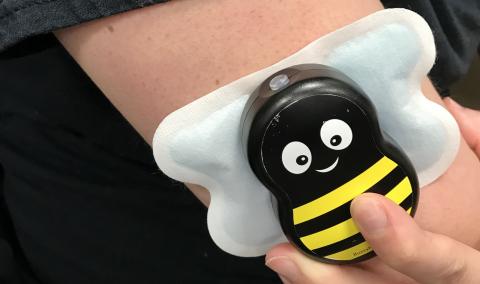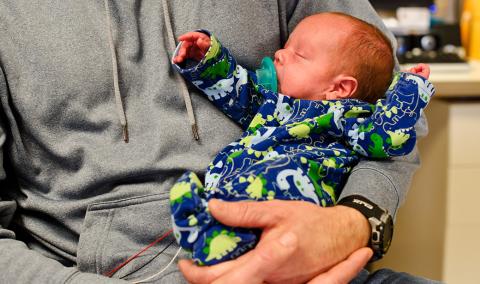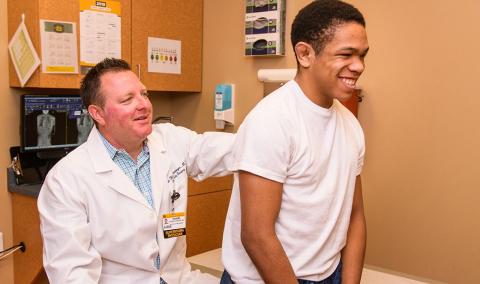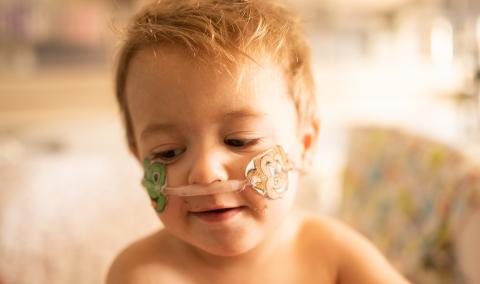Vascular anomalies are abnormal formations or growths of the vascular system, including capillaries, arteries, veins and lymphatic vessels.
When your child is diagnosed with a vascular anomaly, you can trust the child health specialists at University of Missouri Health Care's Children’s Hospital who are experienced in treating children with these conditions and will work with you and your family through every step of the treatment process. Our pediatric doctors have specialty training, and because MU Health Care is an academic health center, our doctors work as a team from multiple departments to make sure your child receives the safest and best care possible.
Types of vascular anomalies
Vascular anomalies are broadly categorized as vascular tumors, hemangiomas or vascular malformations, and our team of pediatric doctors can help.
A hemangioma is a red birthmark made from a collection of blood vessels that is present at birth or within the first few weeks of life that is often seen on the head, chest or back. Infant hemangiomas are the most common type of vascular tumor. While typically bright red and firm, as a hemangioma grows, the color may be more bluish if the hemangioma is in the deeper tissues rather than right beneath the skin. As they gradually regress, their color changes to a gray-purple and they become softer. Hemangiomas may disappear completely or leave behind some excess skin and fibro-fatty tissue after they have resolved. Approximately 80 percent of hemangiomas are solitary lesions, while in 20 percent of cases there is more than one hemangioma present.
Vascular malformations have a variety of appearances depending on the exact composition of the malformation (capillary, arterial, venous, lymphatic or combined). Some only involve the skin, while others are very extensive and may involve deep structures and even the internal organs and bones. Our team of pediatric doctors have specialized training to treat your child if he or she is diagnosed with any of the below vascular malformations:
- Capillary malformation, also known as a "port wine stain"
- Venous malformation
- Lymphatic malformation
- Mixed malformations
- Arterial malformations
- Arterio-venous malformations
- Vascular tumors
Treatment for babies with vascular anomalies
At MU Health Care, we work with you to personalize your child’s treatment plan. Because there are a wide variety of vascular anomalies, there are multiple treatment options available. Some types might only require observation or the use of compression garments to prevent swelling. Other treatment options are available for more advanced types of vascular malformations, including:
- Embolization. This treatment involves blocking off the supply of blood to the malformation.
- Laser treatment: Pulsed-dye laser is the most commonly used laser for vascular anomalies and can be used for some patients with capillary malformations or regressing infantile hemangiomas. The laser utilizes the energy of a specific type of light to break up the blood vessel abnormalities in the skin.
- Oral medications: These treatments are used in some vascular tumors and malformations to minimize growth and sometimes even cause regression of the anomaly.
- Sclerotherapy. This treatment involves an injection of a chemical substance directly into the malformation to shrink it.
- Surgery. We may use surgery to reduce the size of the malformation or, in some cases, to remove the malformation altogether.
- Topical medications: For some superficial or thin vascular tumors, their growth may be controlled with medication applied directly on the skin.
Frequently asked questions about vascular anomalies
Do vascular anomalies cause my baby any pain?
Most of the time, these anomalies are not painful. However, they may be painful if they grow to a large size or if the overlying skin becomes ulcerated.
Who gets vascular anomalies?
Many children have vascular anomalies. Hemangiomas and vascular malformations are not inherited or genetic conditions.
Hemangiomas occur in 2.6 percent of newborns and in 12 percent of Caucasian children by one year of age. They are more common in very small, premature babies and girls are affected three times more often than boys. They are more common in Caucasians than in other racial or ethnic groups.
Vascular malformations occur equally in boys and girls, and there seems to be no racial tendency.
What causes vascular anomalies?
Researchers have not yet pinpointed the exact cause of these anomalies.
What are the main issues related to hemangiomas?
Most hemangiomas cause no problems at all. However, some children with hemangiomas will have problems such as ulceration of the skin and damage to surrounding tissues.
Hemangiomas in the head and neck region can grow large enough to obstruct or interfere with your child's breathing, eating, hearing and/or vision. In rare cases, if your child has a very large hemangioma or multiple hemangiomas, he or she may have bleeding issues or cardiac/circulatory problems.
What are the main issues related to vascular malformations?
Vascular malformations are so varied that it is difficult to generalize about them. Many of these lesions do not cause any problems. However, depending on the type of lesion, its size, location, and composition, there may be various problems such as distortion of surrounding tissues including bones, bleeding and circulatory problem, limitation of function (for example, if the malformation is in the hand), or pain.
What specialists will be involved in my baby's care?
As an academic health center, our doctors have additional training in pediatric procedures and work with other departments to provide the best care for your child. This team of doctors specialize in treating children with vascular abnormalities and include dermatologists, general surgeons, interventional radiologists, ophthalmologists, otolaryngologists (ear, nose and throat doctors) and plastic surgeons.
Learn more about Children's Health at MU Health Care.
Related Conditions & Treatments
- Adolescent Medicine
- Chest Wall Deformities
- Down Syndrome
- Emergency Care for Kids
- Gastrostomy and Feeding Access Program
- Hyperbaric Oxygen Therapy
- Juvenile Diabetes
- Neonatology
- Pediatric Anesthesiology
- Pediatric Cancer
- Pectus Carinatum
- Pectus Excavatum
- Pediatric Cardiology
- Pediatric Dermatology
- Pediatric Development and Behavior
- Pediatric ENT (Ear, Nose and Throat)
- Pediatric Epilepsy
- Pediatric Eye Care
- Pediatric Gastroenterology
- Pediatric Infectious Diseases
- Pediatric Inpatient Rehabilitation
- Pediatric Nephrology
- Pediatric Neurology
- Pediatric Neurosurgery
- Pediatric Orthopaedics
- Pediatric Plastic Surgery
- Pediatric Primary Care
- Pediatric Psychiatry
- Pediatric Pulmonary Medicine
- Pediatric Sleep Medicine
- Pediatric Surgery
- Pediatric Surgical Services
- Pediatric Urology
- Pediatric Vascular Anomalies
- Pediatric Weight Management
- Sickle Cell Disease
- Aerodigestive Program



























